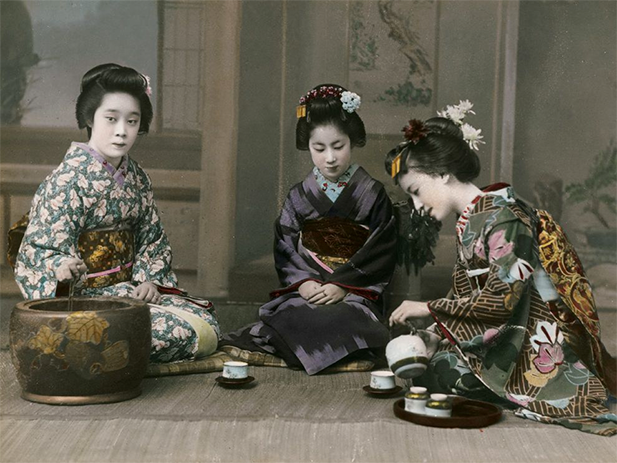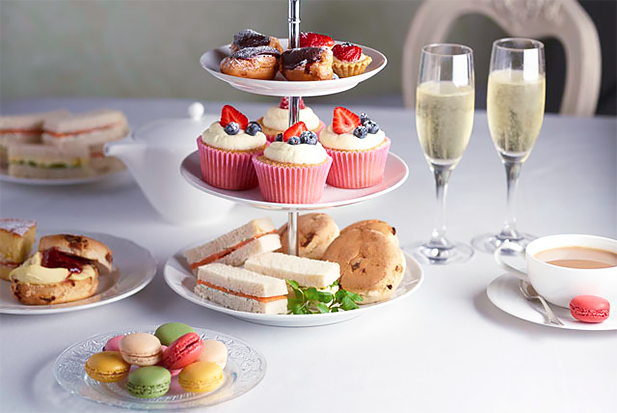
A demonstration of the Japanese tea ceremony. Photo credit: Our Camden.
Tea is enjoyed all over the world as an herbal remedy, a rainy day comfort, or simply a breakfast drink. In many cases, tea is consumed as a way to pass the time with others, but Japan and England in particular have elevated tea to the status of ritual. Also known as the Way of Tea, the Japanese tea ceremony chanoyu is a carefully orchestrated performance focused on the powdered green tea, matcha. Governed by rules regulating preparation, serving, and consumption, chanoyu, literally “hot water for tea,” is far more complex than the misleading translation suggests. Conversely, English High Tea, also known as Afternoon Tea, is a relatively unstructured affair. These traditions are not based on religion, family, or rites of passage; they are cultural constructs built around themes of indulgence, status, and aesthetic.
Though the merchants who brought tea to England were men, women established the nation’s enduring obsession. Catherine of Braganza, the Portuguese princess who wed King Charles II, brought her love of tea to English court, where it then trickled down to the aspiring wealthy classes. Recognizing a promising new market, the East India Company began regularly importing tea to England in 1664.
Two centuries later, High Tea emerged when Anna Russell, Duchess of Bedford and Lady of the Bedchamber to Queen Victoria, sought a way to remedy what she called “that sinking feeling” during the late afternoon. The modern convention of a midday lunch was a new feature in nineteenth-century England, and the meal itself was typically very light. To sate her hunger, the duchess requested to have tea with finger sandwiches or small cakes sent to her room each afternoon. In time, she began inviting friends to share gossip over this afternoon snack, and a tradition was born. As Anna Russell was a prominent figure within London society, the practice quickly spread throughout the city. Though High Tea started in the home, women soon relocated outdoors during the warmer months. No longer bound by gendered space, men were encouraged to get involved. Fine china was soon valued as a status symbol, and rich people rushed to display their wealth by having portraits painted featuring all their tea wares.

A selection of sandwiches and desserts for Afternoon Tea. Photo credit: Hellen Grasso.
Today, British people maintain the tradition of High Tea in their homes, though the title is now somewhat tongue-in-cheek. As a nod to the nostalgia of high society, lavish hotels and tearooms offer Afternoon Tea services with artfully decorated cakes, pastries, scones, cookies, and sandwiches, alongside several options of globally sourced teas. For an extra fee, many places also offer champagne.
While High Tea was a snack that evolved into a ritual of indulgence, chanoyu originated as a display of status and morphed into an exercise in minimalism. Buddhist priests brought tea from China to Japan in the early ninth century, in what is known as the Heian period. The priests drank the tea as a stimulant during long hours of contemplation. However, the practice waned and eventually disappeared midway through the century. Chanoyu emerged in the 15th century, as a means for the Japanese elite to form alliances. Rulers, warriors, and wealthy merchants strengthened their social ties over tea and art. Those in possession of highly coveted Chinese artwork gained recognition by using these ceremonies as an opportunity to display their collection.

Matcha and chasen. Photo credit: Farmers’ Almanac.
Originally tea was prepared in the home, and taken out to a special room outside for consumption. The chashitsu, a backyard tea room furnished with sunken hearths for teakettles and alcoves designed to display cherished Chinese hanging scrolls or flower arrangements, emerged in the sixteenth century. Around this time, notable tea master Sen no Rikyū promoted wabicha, which is tea (cha) embodying the wabi aesthetic. Wabi is a tripartite archetype comprised of unpretentious, irregular, and austere beauty. Accordingly, the most valued utensils were unrefined or imperfect. Chanoyu hosts used bamboo teaspoons called chashaku to spoon matcha powder into ceramic tea bowls called chawan. The powder was dissolved with bamboo whisks called chasen. Some of the most popular chawan were unglazed stoneware originally used by farmers. There existed an arbitrary sense of value in these objects, which increased based on whichever tea master had the found object in their possession.
To achieve maximum wabicha aesthetic, tea masters began to model their chashitsu on hermit huts, preferring mud walls and unpainted roofs. As retreats from the world, these tea rooms were intimate settings, intended to fit only three or four tatami guest mats. Ideally, the chashitsu would be situated in a beautiful garden to enhance the connection to nature. Hosts entered through the average-size sadōguchi, while guests were forced to bend down and crawl in through small, square entrances called nijiriguchi. This physical prostration symbolized the transition from the large outside world, to the small sanctuary of the chashitsu.

Palm Court at the Ritz London. Photo credit: The Ritz London.
As with children’s tea parties, High Tea and the chanoyu ceremony are rooted in the spirit of imagination. Modern British luxury hotels such as the Ritz London and Claridge’s London offer Afternoon Tea in opulent rooms decorated with extravagant floral displays and mirrors, and lit by chandeliers. For an average of £50 per person, anyone with “smart” casual clothing can experience an afternoon of high society exposure. These public tea houses are an opportunity for people to see and be seen, whereas private chanoyu ceremonies are about receding from society. In both situations, the tea drinkers are asked to view themselves through a different lens. In these spaces, tea is more than refreshment; it is a transformative cultural event.

Reblogged this on hannahglover.
LikeLiked by 1 person
Great article, I know someone that was part of a formal tea ceremony in Japan. The attention to detail is astonishing.
LikeLike
Thanks! That sounds amazing; I would love to experience a tea ceremony.
LikeLike
What a great post! Loved getting to know both traditions.
Kisses,
BLOG | Taislany
LikeLike